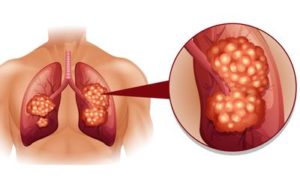
Diagnosed with Cancer? Your two greatest challenges are understanding cancer and understanding possible side effects from chemo and radiation. Knowledge is Power!
Learn about conventional, complementary, and integrative therapies.
Dealing with treatment side effects? Learn about evidence-based therapies to alleviate your symptoms.
Click the orange button to the right to learn more.
- You are here:
- Home »
- Blog »
- Lung Cancer »
- Sugar Feeds Non-small Cell Lung Cancer?
Sugar Feeds Non-small Cell Lung Cancer?

Kim and his collaborators initially set out to investigate differences in metabolism between two major subtypes of non-small cell lung cancer—adenocarcinoma (ADC) and squamous cell carcinoma (SqCC)
Is it true that sugar feeds lung cancer? Yes and no. According to the study linked and excerpted below, sugar feeds squamous cell carcinoma. The other type of NSCLC, adenocarcinoma, is much less dependant on sugar.
The challenge is figuring out what the cancer patient does about it. To put it another way, SqCC is “remarkably more dependant than ADC.” So what? Let me explain.
I am a long-term cancer survivor. When I was trying to figure out how to treat my cancer beyond chemo/radiation/surgery (conventional therapies) I tried to eliminate all sugar from my diet. Sugar feeds cancer, right? I figured out that while cancer cells feed off sugar, it is virtually impossible to remove all sugar from one’s diet. While I have greatly reduced sugars from my diet, especially refinded sugars, if I eat say, fruits and veggies, I will be ingesting fructose, a form of glucose. I think that fruits and veggies are more important to my long-term health than the total elimination of gluose.
I came to the conclusion that nutritional therapies such as angiogeneic supplementation is more important to my daily anti-cancer therapy than anti-sugar is. I take evidence-based anti-angiogenic supplements such as curcumin, resveratrol, green tea extract and more. Scroll down the page to learn about the most bioavailable curcumin formulas.
To learn more about evidence-based therapies for lung cancer, please watch the short video below:
Click here to follow along with the FREE Introduction Guide.
Click here for your FREE First Questions Guide.
The more important take away from the article linked and excertped below is the concept that all cancers are different, genetically speaking. Any two lung cancers, for instance, can be very different, genetically speaking.
Have you been diagnosed with lung cancer? Scroll down the page, post a question or comment and I will reply to you ASAP.
Thank you,
David Emerson
- Cancer Survivor
- Cancer Coach
- Director PeopleBeatingCancer
Recommended Reading:
- Lung Cancer Diet-
- Early Lung Cancer, SBRT if Surgery is Not an Option
- Post Op Chemo Adds Survival to Early Lung Cancer
- Immunotherapy Increases Response to Chemo in Lung Cancer
Study sweetens connection between cancer and sugar
“In a new study, scientists at The University of Texas at Dallas have found that some types of cancers have more of a sweet tooth than others.
“It has been suspected that many cancer cells are heavily dependent on sugar as their energy supply, but it turns out that one specific type—squamous cell carcinoma—is remarkably more dependent,” said Dr. Jung-whan “Jay” Kim, assistant professor of biological sciences and senior author of the study published May 26 in the online journal Nature Communications.
Kim and his collaborators initially set out to investigate differences in metabolism between two major subtypes of non-small cell lung cancer—adenocarcinoma (ADC) and squamous cell carcinoma (SqCC). About one quarter of all lung cancers are SqCC, which has been difficult to treat with targeted therapies, Kim said…
“Prior to this study, it was thought that the metabolic signatures of these two types of lung cancers would be similar, but we realized that they are very different,” Kim said. “These findings lend credence to the idea that cancer is not just one disease, but many diseases that have very different characteristics.”
With elevated GLUT1 implicated in SqCC’s appetite for sugar, the researchers looked for additional evidence by examining human lung tissue and isolated lung cancer cells, as well as animal models of the disease.
“We looked at this from several different experimental angles, and consistently, GLUT1 was highly active in the squamous subtype of cancer. Adenocarcinoma is much less dependent on sugar,” Kim said. “Our study is the first to show systematically that the metabolism of these two subtypes are indeed distinct and unique.”
The researchers also investigated the effect of a GLUT1 inhibitor in isolated lung cancer cells and mice with both types of non-small cell lung cancer.
“When we gave GLUT1 inhibitors to mice with lung cancer, the squamous cancer diminished, but not the adenocarcinoma,” Kim said. “There was not a complete eradication, but tumor growth slowed.
“Taken in total, our findings indicate that GLUT1 could be a potential target for new lines of drug therapy, especially for the squamous subtype of cancer…”
The Most BioAvailable Curcumin Formulas
“Based on a review of these studies, it is evident that better bioavailability of formulated curcumin (CU) products is mostly attributed to improved solubility, stability, and possibly low first-pass metabolism”
A search of the Pubmed database for the word curcumin yields 601 studies spaning health topics from multiple myeloma and colorectal cancer, to chemotherapies that synergizes with CU, to Alzheimer’s Disease, arthritis and more. Based on years of reading studies and personal accounts, I think it is safe to say that CU supplementation is safe and relatively inexpensive.
I have read about myeloma patients taking daily doses of CU from 400 milligrams to 8 grams (1000 milligrams = 1 gram). By almost any measure, CU is a safe, inexpensive wonder drug.
The only challenge is that CU is famously difficult to absorb in the body. In other words, a person has to mix curcumin with some sort of fat (coconut oil, chocolate, etc.) or take a brand of curcumin capsule that is already formulated to be more “bioavailable” in order to derive the full benefit of CU.
The study linked and exerpted below reviews different formulations of CU. The study itself lists the three most bioavailable formulation/brand of CU and I’ve added an excerpt from a further review from Consumerlab.com that lists four additional bioavailable brands of CU.
Recommended Reading:
- CU versus Turmeric as Cancer Therapy-What’s the Difference?
- CU Suppresses Colon Cancer, Enhances Chemotherapy
- Prostate Cancer: CU Curbs Prostate Cancer Metastases, Study Shows
- CU vs. cancer: The scientific evidence continues to pile up
Curcumin
“CU is a bright yellow chemical produced by some plants. It is the principal curcuminoid of turmeric (Curcuma longa), a member of the ginger family, Zingiberaceae. It is sold as an herbal supplement, cosmetics ingredient, food flavoring, and food coloring.[1]“
Bioavailable curcumin formulations: A review of pharmacokinetic studies in healthy volunteers.
“Curcumin is a widely studied natural compound which has shown tremendous in vitro therapeutic potential. Despite that, the clinical efficacy of the native CU is weak due to its low bioavailability and high metabolism in the gastrointestinal tract. During the last decade, researchers have come up with different formulations with a focus on improving the bioavailability of curcumin. As a result, a significant number of bioavailable curcumin-based formulations were introduced with the varying range of enhanced bioavailability.
The purpose of this review is to collate the published clinical studies of CU products with improved bioavailability over conventional (unformulated) CU. Based on the literature search, 11 curcumin formulations with available human bioavailability and pharmacokinetics data were included in this review. Further, the data on clinical study design, analytical method, pharmacokinetic parameters and other relevant details of each formulation were extracted.
Based on a review of these studies, it is evident that better bioavailability of formulated curcumin products is mostly attributed to improved solubility, stability, and possibly low first-pass metabolism. The review hopes to provide a quick reference guide for anyone looking information on these bioavailable curcumin formulations.
Based on the published reports,
exhibited over 100-fold higher bioavailability relative to reference unformulated CU. Suggested mechanisms accounting for improved bioavailability of the formulations and details on the bioanalysis methods are also discussed.”
According to Consumerlab.com:
“Novasol has the highest bioavailability (185 x compared to unforumulated CU), followed by Curcuwin (136 x), Longvida (100 x), Meriva (48 x), BCM-95 (27 x), Curcumin C3 Complex + Bioperene (20 x), and then Theracumin (16 x).”




